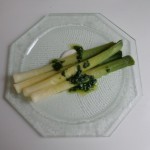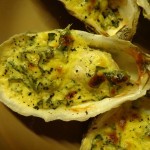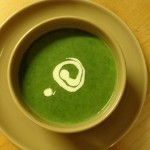 The leek is a handsome vegetable. The ancient Egyptians grew and enjoyed it, and so did the Romans — in fact, it was reputedly Nero’s favorite vegetable. The Welsh enjoy it so much that they made it their national emblem. Milder than the onion, the leek makes frequent appearances in European cuisine, notably in France and Belgium. So why are leeks so rarely seen in American cooking? One person here in Paris who’s not afraid of leeks is Shaun Kelly — but he’s Australian, not American. At his restaurant, Au Passage, he made a leek starter the other day that was so delightful I had to try to replicate it.
The leek is a handsome vegetable. The ancient Egyptians grew and enjoyed it, and so did the Romans — in fact, it was reputedly Nero’s favorite vegetable. The Welsh enjoy it so much that they made it their national emblem. Milder than the onion, the leek makes frequent appearances in European cuisine, notably in France and Belgium. So why are leeks so rarely seen in American cooking? One person here in Paris who’s not afraid of leeks is Shaun Kelly — but he’s Australian, not American. At his restaurant, Au Passage, he made a leek starter the other day that was so delightful I had to try to replicate it.
Poireaux sauce verte / Warm young leeks with a green herbal sauce
Leeks are also delicious served as a starter with mustard vinaigrette and many other sauces — or just with sea salt and a fine extra-virgin, cold-pressed olive oil. But this herbal sauce adds a little je-ne-sais-quoi that lifts the leeks out of the ordinary. As the leek is a winter vegetable — and spring finally seems to be around the corner — the time to try this dish is now. Leeks won’t be on the menu for long. Happy cooking!


 This is the longest and dreariest winter I can remember in my more than 30 years in Paris. Gray, gray, gray every day, and it keeps snowing at a time of year when the café tables have usually started to come out, giving Parisians a chance to sip an apéritif in the sun and enjoy the lift that comes with the feeling that spring is just around the corner. By late February I normally get an itchy feeling in my fingers telling me it’s time to go down to Burgundy and trim the raspberry bushes. None such this year. Instead, I’m working on creating cheery winter dishes that can warm the soul on a cold and blowy night.
This is the longest and dreariest winter I can remember in my more than 30 years in Paris. Gray, gray, gray every day, and it keeps snowing at a time of year when the café tables have usually started to come out, giving Parisians a chance to sip an apéritif in the sun and enjoy the lift that comes with the feeling that spring is just around the corner. By late February I normally get an itchy feeling in my fingers telling me it’s time to go down to Burgundy and trim the raspberry bushes. None such this year. Instead, I’m working on creating cheery winter dishes that can warm the soul on a cold and blowy night.








